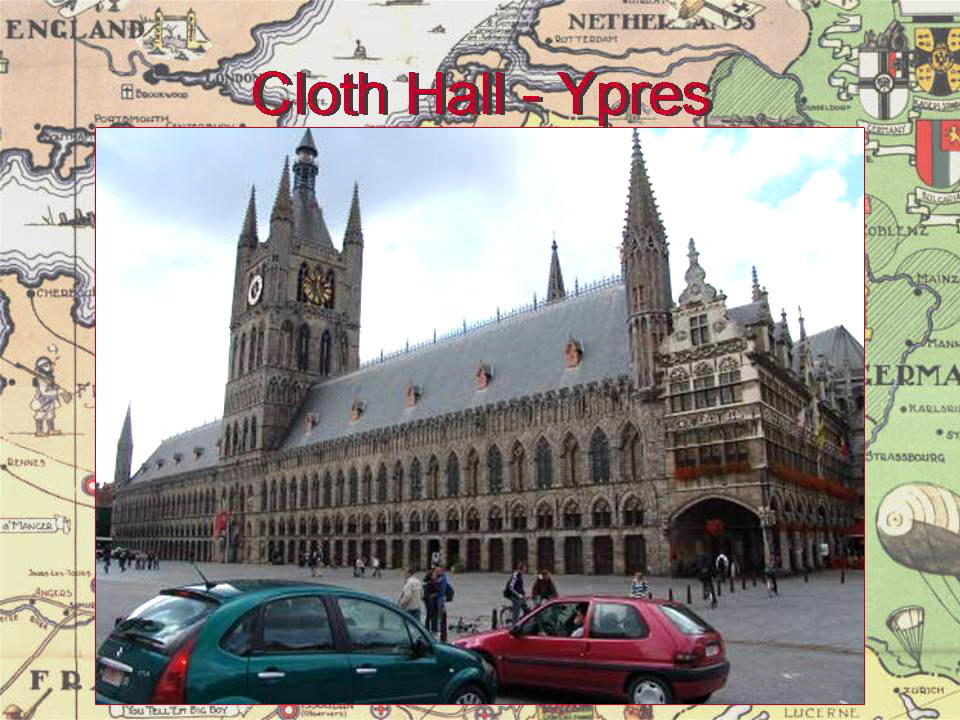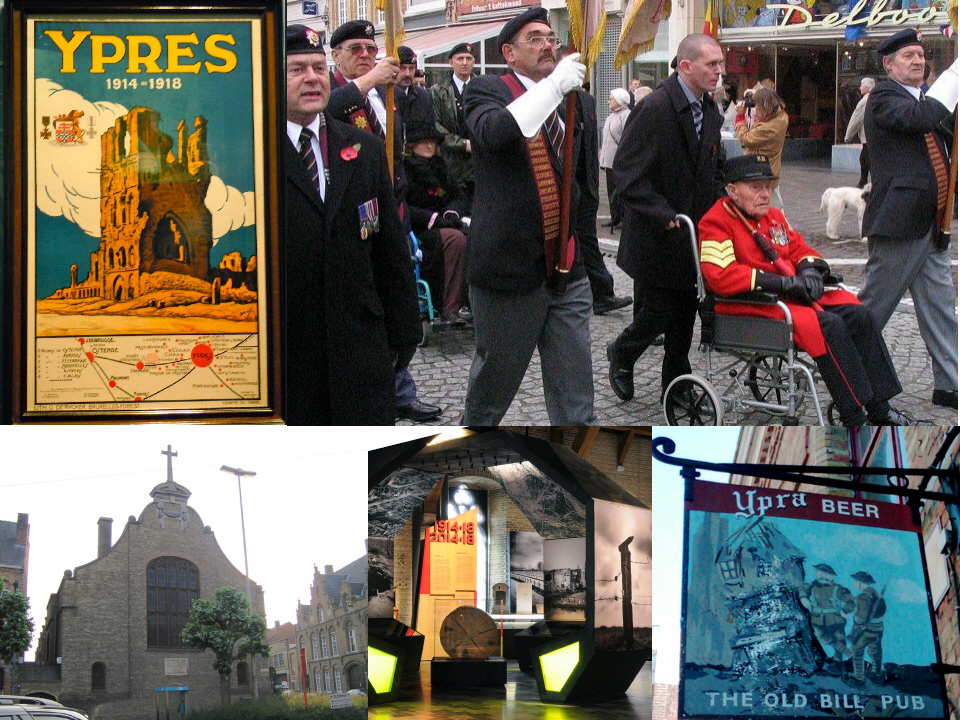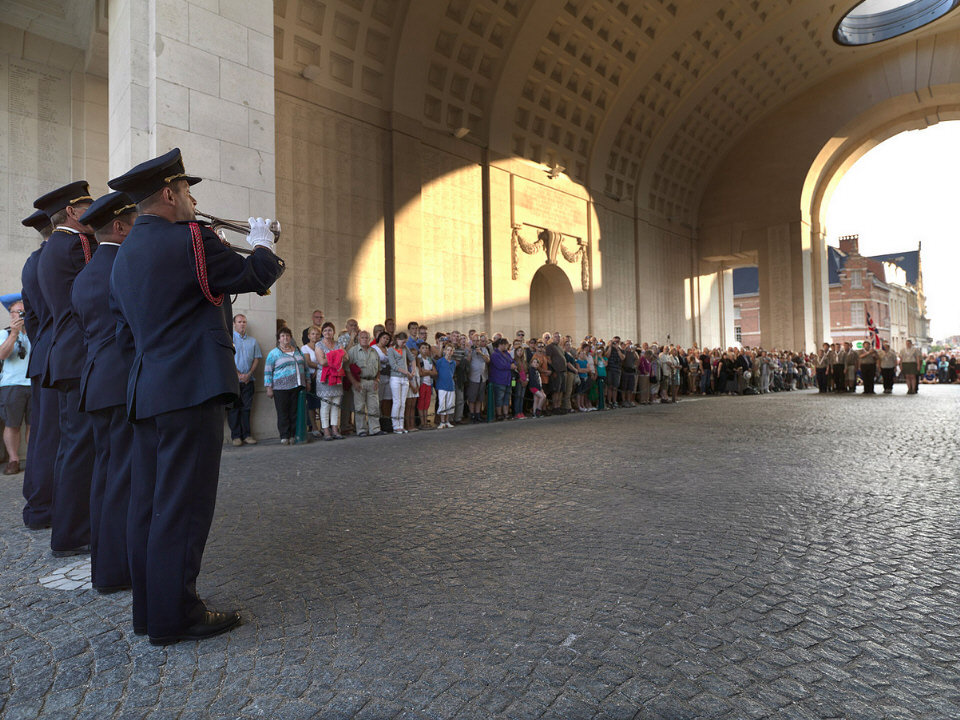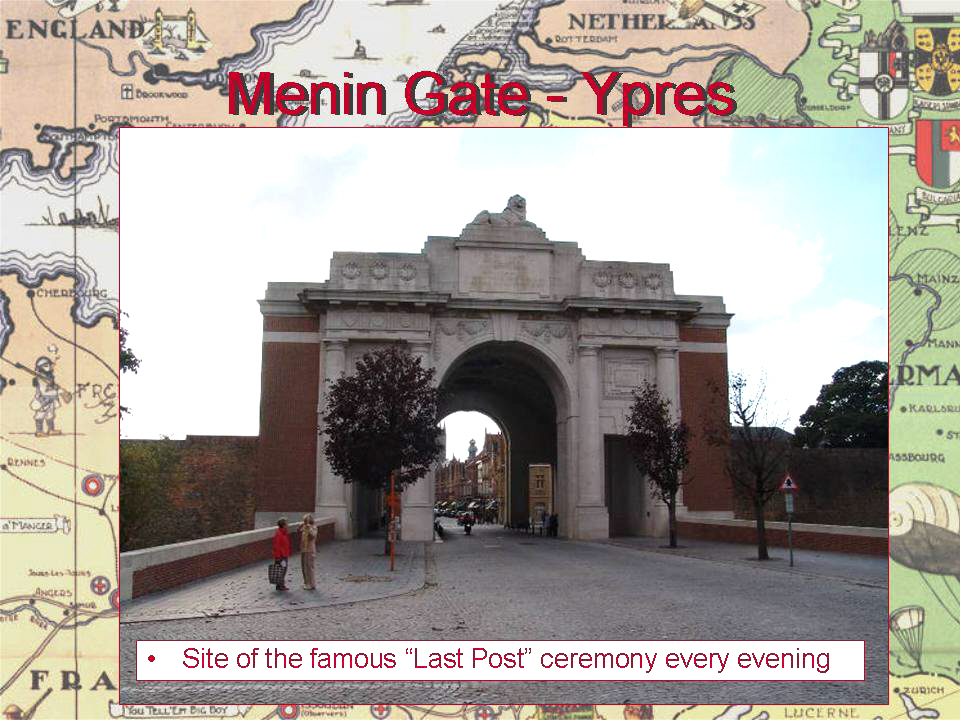
The Ypres Salient, of course is a major destination for any visitor to the Western Front and just jam-packed with notable sites to visit. We have organized this part of our tour in four parts, the town of Ypres, north of the town, down the Menin Road, and south of the town. We will begin and complete Stop 4 with the two most famous structures in the town.
Click on Image to Expand

In 1914 the Germans wanted to seize the crucial Channel ports in France and flank the Allied forces in the famous "Race to the Sea." This meant that they had to capture Ypres first. In October the fight for the ridges and hills led to a concentration of forces by both sides. What quickly developed became known as the First Battle of Ypres. A salient was formed around the town — a huge bulge in the British lines that jutted deep into the German-held territory. The nearby territory was fought over for nearly the entire war, with the British Army never yielding the town despite dramatic back and forth movement of the front.
The Belgian Army occupied the sector north of Ypres from its canal up through Diksmuide to the coast at Nieuwpoort. The French Army also deployed substantial forces to Flanders. The Ypres Salient, then and today, however, is most closely associated with the sacrifices of the British Army in the Great War. The Tommies affectionately named the town "Wipers."

The Belgian Army occupied the sector north of Ypres from its canal up through Diksmuide to the coast at Nieuwpoort. The French Army also deployed substantial forces to Flanders. The Ypres Salient, then and today, however, is most closely associated with the sacrifices of the British Army in the Great War. The Tommies affectionately named the town "Wipers."
Click on Image to Expand

From the Top: An early poster for battlefield tourism to Ypres; one of the last surviving veterans of the fighting in the Salient being escorted to the Last Post Ceremony (2005); St. George's Memorial Church, the Salient Museum at the Cloth Hall; "Some corner of a foreign field that is forever England," — a British Pub in Ypres.
The Menin Gate and the Last Post Ceremony
Nightly at 8 p.m. since 1928, traffic has been halted and the Last Post bugle call sounded under the Arch of the Menin Gate Memorial. This ceremony, conducted in the Flanders market town of Ypres is a defining experience for every pilgrim to the Western Front. The memorial recalls the sacrifice of the fallen soldiers of the British Empire in the defense of the Ypres Salient during the 1914–18 war. The names of over 54,000 missing service men are engraved on the panels of this memorial.
A committee consisting of local inhabitants arranged in 1928 for the nightly ceremony, which takes place, year in year out, in rain or snow or gloom of night. On stormy winter nights only a handful of visitors witness the event, but at the height of tourist season thousands may be present including veterans marching in formation and groups of school children from the contesting nations. Buglers of the local volunteer fire brigade are given the privilege to pay this tribute to the fallen soldiers. A fund was raised through contributions from local townspeople and later also from gifts by the British Commonwealth sympathizers in order to meet the expense.

Buglers of the Ypres Fire Brigade and a Typical Crowd at the Last Post Ceremony
The sounding of the Last Post is the main token of gratitude by the Ypres inhabitants toward the nearly 400,000 Allied servicemen who fell in action in defense of the Ypres Salient. The numerous cemeteries and monuments in the area are silent witnesses to the tremendous loss incurred in defending an area ten by twenty miles. The dead and missing came from every Allied country: Great Britain, but also Canada, Australia, New Zealand, South Africa, Newfoundland, India, Pakistan, Ceylon, China, France and its colonial Empire, the United States, Portugal as well as Belgium. Through the years the Last Post ceremony has become part of the daily life in Ypres. It brings to memory the long and tragic misery of the years of war and their aftermath. The ceremony was forbidden during the German occupation of World War II but resumed the very evening Canadian Forces relieved the town in 1944.
Nightly at 8 p.m. since 1928, traffic has been halted and the Last Post bugle call sounded under the Arch of the Menin Gate Memorial. This ceremony, conducted in the Flanders market town of Ypres is a defining experience for every pilgrim to the Western Front. The memorial recalls the sacrifice of the fallen soldiers of the British Empire in the defense of the Ypres Salient during the 1914–18 war. The names of over 54,000 missing service men are engraved on the panels of this memorial.
A committee consisting of local inhabitants arranged in 1928 for the nightly ceremony, which takes place, year in year out, in rain or snow or gloom of night. On stormy winter nights only a handful of visitors witness the event, but at the height of tourist season thousands may be present including veterans marching in formation and groups of school children from the contesting nations. Buglers of the local volunteer fire brigade are given the privilege to pay this tribute to the fallen soldiers. A fund was raised through contributions from local townspeople and later also from gifts by the British Commonwealth sympathizers in order to meet the expense.
Click on Image to Expand

Buglers of the Ypres Fire Brigade and a Typical Crowd at the Last Post Ceremony
The sounding of the Last Post is the main token of gratitude by the Ypres inhabitants toward the nearly 400,000 Allied servicemen who fell in action in defense of the Ypres Salient. The numerous cemeteries and monuments in the area are silent witnesses to the tremendous loss incurred in defending an area ten by twenty miles. The dead and missing came from every Allied country: Great Britain, but also Canada, Australia, New Zealand, South Africa, Newfoundland, India, Pakistan, Ceylon, China, France and its colonial Empire, the United States, Portugal as well as Belgium. Through the years the Last Post ceremony has become part of the daily life in Ypres. It brings to memory the long and tragic misery of the years of war and their aftermath. The ceremony was forbidden during the German occupation of World War II but resumed the very evening Canadian Forces relieved the town in 1944.
Click on Image to Expand


When Field Marshal Sir John French unveiled the Menin Gate Memorial in about 1927, he referred to the many thousands of names of those killed fighting in the Ypres Salient durin WW I whose bodies were never recovered and/or fully identified. He said to the audience words to the effect, "If you wonder where are all the missing, they are here!" He was referring to the thousands of names inscribed on the monument.
ReplyDeletetmorgan58@hotmail.com
It puzzles me that the designers of the Menin Gate Hall of Memory apparently underestimated the needed size by so much that all of the missing from Aug. 1917 on had to be listed on the memorial at Tyne Cot.
ReplyDelete